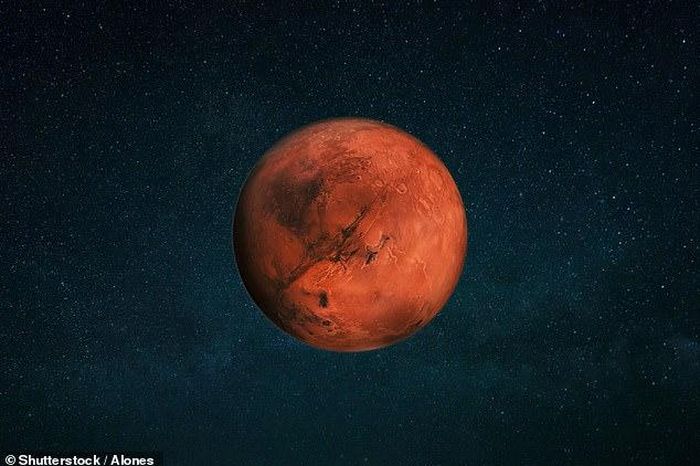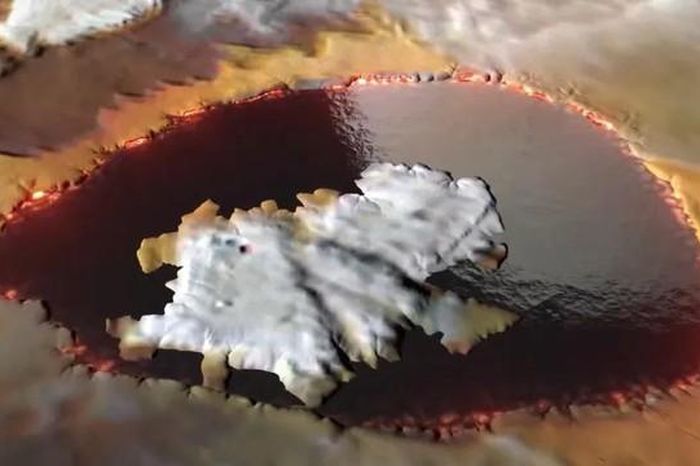Experts are confident that China can surpass the US to become the first country to bring samples from Mars to Earth
'China will launch the Tianwen 3 spacecraft around 2030 to carry out a Mars sampling mission,' Wu Weiren said in a keynote speech at the China Space Conference in Wuhan City, Hu Province North recently.
Wu Weiren, who is also Director of the newly established Deep Space Exploration Laboratory in Hefei City (Anhui Province), said: 'In light of the advances being made around the world, we plan to Ant will become the first country to take samples from Mars'.
Wu Weiren is the first senior Chinese space official to publicly make such a prediction. In addition, he revealed that China has begun planning the project to build the world's first Mars sample laboratory.
Sun Zezhou, Wu Weiren's colleague and chief designer of the 2021 Tianwen 1 mission, said last month that all key technology needed for Tianwen 3 was ready and work was progressing smoothly .
'Until now, no country has been able to take samples from Mars,' Sun Zezhou told CCTV, adding that China must overcome two major challenges for the mission to take place. Thien Van 3 was successful.
'One is to take rock samples and then take off from the Martian surface. The second is orbital rendezvous and sample transfer to the return ship to Earth. They require our spacecraft to be extremely intelligent at the system design level,' Sun Zezhou said.
According to Sun Zezhou, when analyzing rock samples obtained with modern equipment on Earth, scientists can better answer basic questions such as whether there is still water on Mars and whether the red planet exists. at any form of life in the past or not.
China is increasingly likely to become the first country to conduct a sampling mission on Mars, although the US has a much longer history of exploring the red planet, dating back to the 1960s.
To date, China and the US are the two rare countries to soft-land on Mars, one of the few places in the solar system where life could exist, making it a prime destination for exploration.
The Thien Van 1 spacecraft helped China become the second country after the US to soft-land on the red planet in 2021.
Soft landing on Mars is the process of bringing a spacecraft to the surface of Mars safely and gently, minimizing impact and damage. This is a very complicated technique because the Martian environment is harsh with a thin atmosphere, weak gravity and a rough surface.
To perform soft landings, spacecraft often use a combination of methods, including:
Acceleration system: Helps reduce the spacecraft's speed as it enters the Martian atmosphere. This system may include parachutes, speed plates or jet engines.
Navigation system: Helps navigate the spacecraft to the desired landing location and avoid obstacles. This system often uses cameras, radar and lidar.
Shock absorber system: Helps absorb impact when the spacecraft hits the ground. This system may include airbags, springs or hydraulic dampers.
NASA (US Aeronautics and Space Administration) also hopes to bring Martian rocks to Earth around 2030. NASA's Perseverance exploration robot has collected a number of samples in tubes and is waiting to be retrieved. on the surface of Mars.
However, the budget of the Mars sampling program increased dramatically, from about $4 billion to $11 billion, forcing NASA to abandon the original plan in early April, leaving the mission date uncertain. .
An independent review last year found that even if NASA could afford the $11 billion needed for the mission, any samples would not be returned to Earth until 2040.
NASA Administrator Bill Nelson said the agency is looking for suggestions on faster and cheaper ways to collect samples. 'We need to look further to find a path that is both affordable and returns samples within a reasonable time frame,' he said.
Over the past few months, NASA's work on the Mars Sample Return project has slowed due to budget uncertainty and an independent review that criticized the project's timeline. judgment is "unrealistic".
Mars Sample Return is set to collect Martian rock samples, currently collected by NASA's Perseverance rover at Jezero Crater, and return them to Earth around 2030. The total cost has increased from $4 billion USD initially and likely to increase to 11 billion USD.
According to an independent assessment, the probability that NASA and its European partners will be ready to launch spacecraft in 2028, to be able to catch up with Mars sampling and return to Earth in 2030, is 'close'. like equal to 0'.
In February, the Jet Propulsion laboratory in Pasadena (California), NASA's leading Mars Sample Return development unit, laid off 8% of its staff because of possible spending cuts from the US Congress, especially especially for this project.
Despite the delays and uncertainty, scientists remain hopeful that the Mars Sample Return program will come to fruition because its sampling sites are diverse and carefully selected for their high scientific value. .
By comparison, Thien Van 3 is more likely to be limited to collecting and sampling right next to the Mars lander.
In addition to Thien Van 3 and Mars Sample Return, India and Europe will also soon launch missions to Mars. India's and Europe's respective spacecraft, Mars Orbiter Mission 2 and ExoMars Rosalind Franklin rover, are expected to be launched in 2024 and 2028 but will not carry out sampling missions on Mars.
NASA's exploration of Mars began five decades ago. In 1976, NASA's Viking 1 and Viking 2 became the first spacecraft to touch down on the red planet. Landing attempts by the Soviet Union and the European Space Agency then ended in failure.
China is a latecomer in exploring Mars. In 2021, China's Tianwen 1 spacecraft successfully deployed a rover around Mars' orbit, landing a lander and rover on the surface of the red planet.
China is also the only country in the past 50 years, since the end of the Apollo era in 1972, to have brought back rock samples from the Moon.
America attempted to return to the Moon earlier this year. A NASA-backed commercial lunar lander failed to reach its destination, and a second lander overturned during landing and survived for several days.
You should read it
- The strangest objects ever taken on Mars surprised many
- 5 most interesting findings about Red Planet
- Stunned to discover river fossils on Mars
- There are major changes in the atmosphere of Mars
- Find strong evidence of life on Mars
- Why are microorganisms living 'so tough' on Earth but still hard to survive on Mars
 Nokia is about to bring 4G network to the Moon
Nokia is about to bring 4G network to the Moon NASA found traces of methane gas near a crater on Mars
NASA found traces of methane gas near a crater on Mars The Voyager 1 spacecraft sent signals to Earth for the first time in 5 months
The Voyager 1 spacecraft sent signals to Earth for the first time in 5 months The Voyager 1 spacecraft resumes sending technical updates back to Earth
The Voyager 1 spacecraft resumes sending technical updates back to Earth Hubble telescope discovers more than 1,000 new asteroids
Hubble telescope discovers more than 1,000 new asteroids Clip NASA: 'Glass lake' in the most terrible place in the solar system
Clip NASA: 'Glass lake' in the most terrible place in the solar system